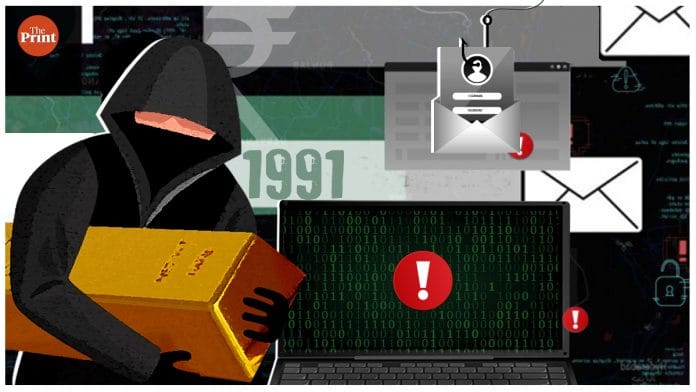New Delhi: From Deewar to Don to Amar Akbar Anthony, Bollywood in the 1970s and 1980s revolved around gold smuggling. And there was a reason why it caught the fancy of filmmakers.
Restrictions on gold imports in the pre-1991 era meant that gold smuggling was a very lucrative business with many organised crime groups, especially the Mumbai underworld, making huge profits from this illegal activity.
The underworld flourished after the Gold (Control) Act of 1968 prohibited Indians from holding gold in the form of bars and coins, making smuggling highly lucrative. However, this changed to a large extent after 1992.
As part of the historic reform process that started in 1991, then finance minister Manmohan Singh legalised gold imports in his February 1992 budget speech.
While imposing a duty of roughly 15 per cent on the value of gold imported, Singh said, “One of the reasons why foreign exchange is diverted to illegal channels is the illegal import of gold. It is time we took a bold step to recognise the realities of the situation and legalise the import of gold. Government proposes to allow returning Indians and NRIs to import 5kg of gold per passenger with a modest import duty provided the gold as well as the import duty is financed from foreign exchange earned abroad.”
He added, “I am confident that this step will be welcomed by all, except those engaged in the hitherto profitable business of smuggling this metal into the country.”
Duties were progressively reduced to single digits over the years effectively turning gold smuggling non-lucrative till 2012 when it again resumed after the Union government decided to reimpose import duties.
However, while the 1991 reform process reduced one form of crime, there were many challenges that persisted.
Also read: If we raise duties to make Indian industry competitive, we’ll end up close to 1991: Montek
Changing nature of crimes
Two stock market scams, the Harshad Mehta scam discovered in 1992 and the Ketan Parekh scam that came to light a few years later, posed a stiff challenge to the newly formed capital markets regulator, the Securities Exchange Board of India.
The Harshad Mehta scam took nearly four years to come to light mainly because all the trading of shares was in physical form and not in the dematerialised form or online.
Over the years, the regulator has brought in many changes to rules and regulations to tighten loopholes that have been progressively exploited over the years.
The 1991 reforms also facilitated India’s integration into the world economy through trade and investment ties. Gradually reducing barriers on imports and encouraging foreign investment into the country also enabled India’s technology push.
The advent of technology also saw the nature of crimes change with more sophisticated cyber-related crimes gaining traction making life difficult for law enforcement authorities and financial market regulators.
With access to the internet, mobile phones and laptops, cheating and duping for monetary benefits through online scams formed a major portion of cyber crimes.
Data with the National Crime Records Bureau shows that cases registered related to cyber crimes rose 64 per cent in 2019 at 44,546 as compared to 2018. Of these, 60.4 per cent were with the motive of fraud and 5 per cent with an aim of sexual exploitation.
Additionally, with greater global integration of the Indian economy into the world economy, trade related financial transactions also gave rise to frauds that were difficult to detect by financial institutions.
One of the biggest scams in recent years has been the $1.8 billion (around Rs 13,000 crore) scam involving jewellers Nirav Modi and Mehul Choksi. It was found that officials of the Punjab National Bank issued letters of undertaking — a bank guarantee against which another lender gives a foreign currency loan — to firms associated with the two jewellers without seeking any collateral from these firms.
Also read: Cairn targets Indian assets in Paris: What is its dispute with Modi govt & why it’s escalated
‘Cyber crime now underpins nearly all crimes’
M.N. Singh, former Mumbai Police commissioner, pointed out that the use of technology has made it easier to commit tech and financial crimes.
“Cyber crime has an important role in today’s crime scenario. In 1991, cyber crime was almost non-existent. But now it underpins nearly all crimes. Banking and financial frauds have also undergone a change after the induction of technology,” he said.
“Technology has led to crime becoming a sophisticated profession and created additional hurdles for the police to nab the criminals,” added Singh.
Neeraj Kumar, former Delhi Police commissioner, pointed out that the change in crime patterns in the last couple of decades has been gradual but steady.
For instance, even the nature of stalking has changed from only physical stalking to increasing usage of phones and computers, he said. “From these crimes to financial crimes to terrorism — everything has been upgraded due to the internet,” he said.
“Banking frauds, phishing — all taking place behind computer screens is the new dimension in crimes. Look at the ‘Jamtara gang’ — those kinds of crimes have been possible only after the advent of mobile phones and the internet,” he said.
The Jamtara district in Jharkhand gained notoriety a few years back after it emerged as the hub for cyber crimes, also inspiring a homonymous web series on OTT platform Netflix.
Kumar added that NPAs of banks have also risen due to such frauds. “There are more people like Nirav Modi who have indulged in such scams but those cases haven’t got the limelight.”
(Edited by Amit Upadhyaya)
Also read: Mukesh Ambani calling — Reliance to buy majority stake in Just Dial to expand digital offering






